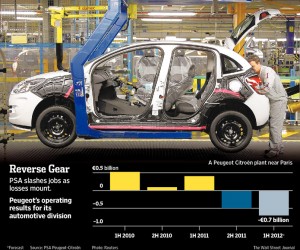Let’s face it. The economy is still lousy, and many companies are trying to find ways on how to reduce their costs. For General Motors and Peugeot-Citroen, it is time to restructure their operations.
“GM removed the head of its European operations, Karl-Friedrich Stracke, after just seven months on the job and replaced him with Vice Chairman Steve Girsky amid growing frustration with the pace of the turnaround at its European business, which includes the German Opel/Vauxhall unit” (Terlep). “Peugeot plans to eliminate 8,000 jobs, or 8%, of its French workforce, and stop building vehicles at one of France’s largest car factories in 2014” (Terlep).
So what exactly are GM and Peugeot restructuring? Both companies are restructuring their operations management, specifically their capacity. In class, we learned about design capacity and effective capacity. Design capacity is the maximum theoretical output of a system, whereas effective capacity is the capacity a firm expects to achieve given current operating constraints.
“About 30 of the 98 European auto-assembly plants owned by major car makers are operating below 70% of their capacity, levels that typically cause plants to run up significant losses. European auto makers have the plant capacity to make 27 million cars a year but will only make 20 million this year” (Terlep). In operations management terms, 30 of the 98 European auto-assembly plants have a design capacity of 27 million cars, but they are operating below 70% of their design capacity. Their effective capacity this year is 20 million cars.
In order for GM and Peugeot to match capacity to demand and effectively compete in the auto industry, they will have to close some of their factories and lay off thousands of their employees. The general environment and the task environment change dramatically every day. Companies who do not build for change will experience what GM and Peugeot are experiencing today. There is a lower demand for cars, and costs are skyrocketing because factories are not operating at their full design capacity.
If you were the chief operating officer at GM or Peugeot, how would you restructure your company and “build for change”?
*If you would like to access my article, you can click on the link below:
BIBLIOGRAPHY
Terlep, Sharon, and Sam Schechner. “GM, Peugeot Take Aim at Europe Woes.” The Wall Street Journal. Dow Jones & Company, 12 July
2012. Web. 12 July 2012. <http://online.wsj.com/article/SB10001424052702303740704577522053739434374.html>.







